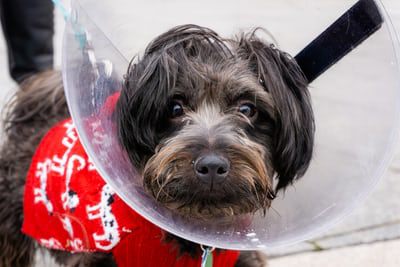Media – Licking Legs & Everything Else
Nausea is Nobody’s Friend
Question:
My dog recently had a lick granulomas removed by laser. He was placed in an Elizabeth (cone) collar. When I take off the collar for him to eat he stops eating to lick the wounds. I have tried to take off the collar and dress the wounds with gauze and duct tape, as well as Boundary. Each time he chewed and licked off the dressings.
Dr. Nichol:
Your poor dog licks incessantly partly because his wounds itch like crazy. Anxiety may be a factor but there is much more to his problem.
Lick granulomas almost always occur on the front surface of one or both of a dog’s wrists. They can start with a small injury. The irritation of the tongue and saliva that’s loaded with bacteria results in a hairless, somewhat swollen, infected sore. Bad tasting concoctions, bandages, scolding, and public humiliation are pointless because they only address the symptom – the unbearable itch. Back in the day, lick granulomas were thought to result from boredom. We have now learned that dogs who get more exercise and social contact with other dogs may improve somewhat but none reach nirvana until the underlying cause is identified and resolved.
Antibiotics, antianxiety medication, and behavior modification have helped some but the latest research has revealed that the fundamental cause of most lick granulomas is stomach and intestinal disease. We now know that the majority of dogs who lick excessively (rocks, floors, carpet, the air, their owners, or their bodies) are chronically nauseated. Licking seems to help them feel a little better.
You could give antacids or make a diet change but if your dog had a voice in his wellbeing he would lobby hard for total relief – ASAP. Evidence-based medicine will be the only path to lasting improvement. I advise a thorough GI workup for your dog. A veterinary internist may recommend abdominal ultrasound, x-rays, and endoscopic biopsies in order to find the answers. To rule-out joint pain, x-rays should also be taken of your dog’s wrists and paws. Behavioral treatment should be started only after all other possibilities have been ruled-out. Your pupster has suffered too long.
Dr. Jeff Nichol, a residency-trained veterinary behaviorist, provides consultations in-person and by telephone and Zoom (505-792-5131). Each week he shares a blog and a Facebook Live video to help bring out the best in pets and their people. Sign up at no charge at drjeffnichol.com. Post questions on pet behavioral or physical concerns on facebook.com/drjeffnichol or by US Post to 4000 Montgomery Blvd. NE, Albuq, NM 87109.


